The “Page with Redirect” error in Google Search Console can sometimes confuse users. These messages, however, don’t always mean there’s a problem with your redirects. Sometimes it’s Google’s way of telling you the redirect is working as expected.
This guide will help you understand:
- What the “Page with Redirect” message means in Google Search Console.
- When to worry about the messages.
- How to address the underlying issues that can impact your SEO performance.
Key Takeaways
- The Page with Redirect status in Google Search Console isn’t always bad.
- Only fix unexpected redirect errors that impact your site’s SEO.
- Most redirect messages are normal and expected behavior.
- Focus on fixing redirect chains, loops, and outdated internal links.
- Test redirect changes to measure their impact on organic traffic.
Table of Contents
- What Does “Page with Redirect” Mean in Google Search Console?
- Should You Be Worried About “Page with Redirect” in Google Search Console?
- Common Causes of Redirect Issues
- How to Fix “Page with Redirect” Issues
- How to Test the Impact of Redirect Changes
- Frequently Asked Questions
What Does “Page with Redirect” Mean in Google Search Console?
The “Page with Redirect” message appears in Google Search Console when Google attempts to crawl a URL but is redirected to a different page. Google excludes these pages from its index because they’re not the final destination to which users are taken.
When Google lands on a page (to crawl it) and finds a redirect, it follows that path in order to find the final URL. The original URL gets marked as a “Page with Redirect” and the final URL gets indexed instead.
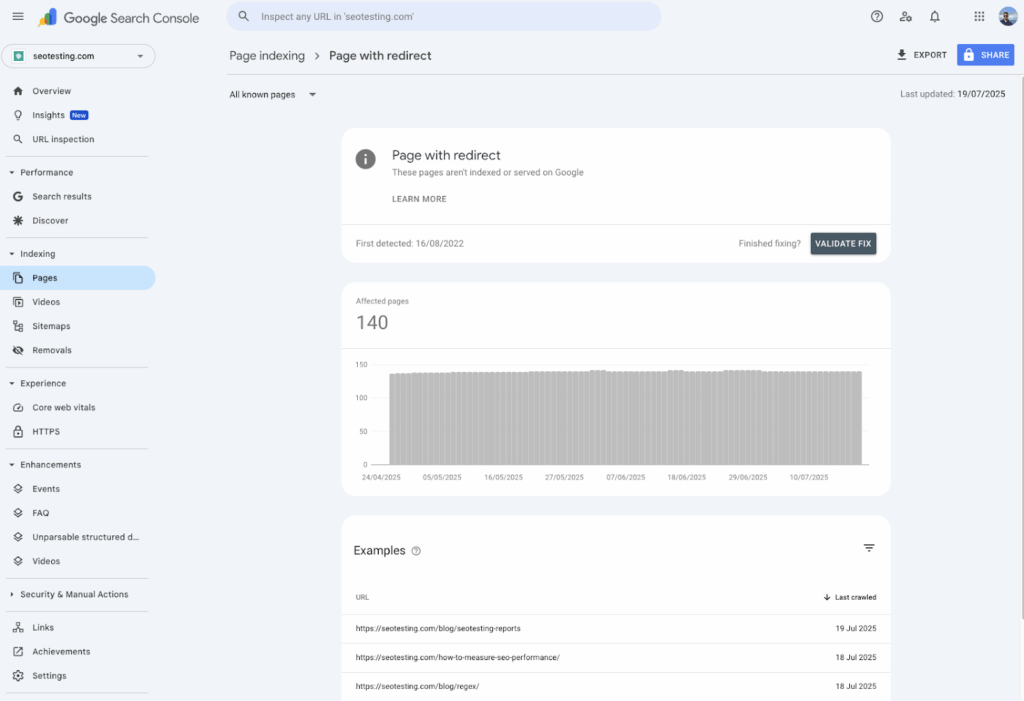
Common Examples of Expected Redirects
These redirect scenarios are normal and expected:
HTTP to HTTPS Redirects
- http://example.com/page → https://example.com/page
- This is the standard security practice for all modern websites.
Old Blog Post URLs
- example.com/2023/01/old-post-title → example.com/blog/new-post-title
- This happens when a site’s URL structure changes or content is consolidated.
Non-WWW to WWW (Or Vice Versa)
- example.com → www.example.com
- This happens due to different domain canonicalization preferences.
Should You Be Worried About “Page with Redirect” in Google Search Console?
When you see a “Page with Redirect” error appear within Google Search Console, one of two situations could be happening:
Firstly, the message in GSC could be totally expected, and Google Search Console is simply telling you that the redirect you have put in is working as expected, and you can leave the message alone within your Google Search Console account.
There are lots of scenarios that are normal and will not harm your rankings. Let’s say, for example, that you’ve recently restructured your website, moved from HTTP to HTTPS, or consolidated similar pages. Google Search Console will flag these redirects as it encounters them.
Secondly, there could be a problem with a redirect (or a group of redirects) on your website. If this is the case, this is when you need to take action in order to stop the message showing up in Google Search Console.
Common Causes of Redirect Issues
Sometimes, the “Page with Redirect” message in Google Search Console indicates that there is a redirect error that needs to be fixed. Understanding the common causes of problematic redirects will help you identify which issues require immediate attention and which ones you can safely ignore and move past.
Redirect Chains or Loops
A redirect chain happens when one redirect takes too many “hops” before it actually reaches its final destination.
Here’s what a redirect chain looks like:
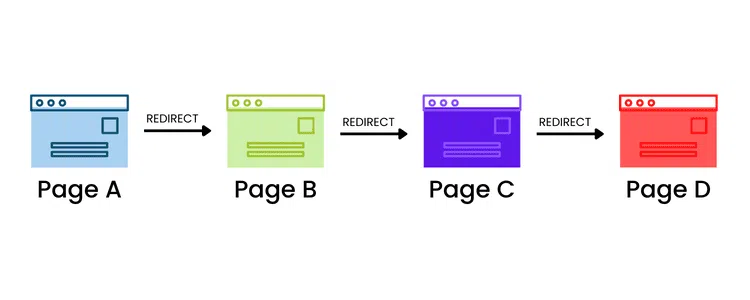
While Google can still follow these redirect chains, they slow down crawling and can confuse the search engine bots on your site. Not great for having a well-optimized site.
Redirect loops, however, are even more problematic! This happens when you create an endless cycle where Page A redirects to Page B, which then takes you straight back to Page A.
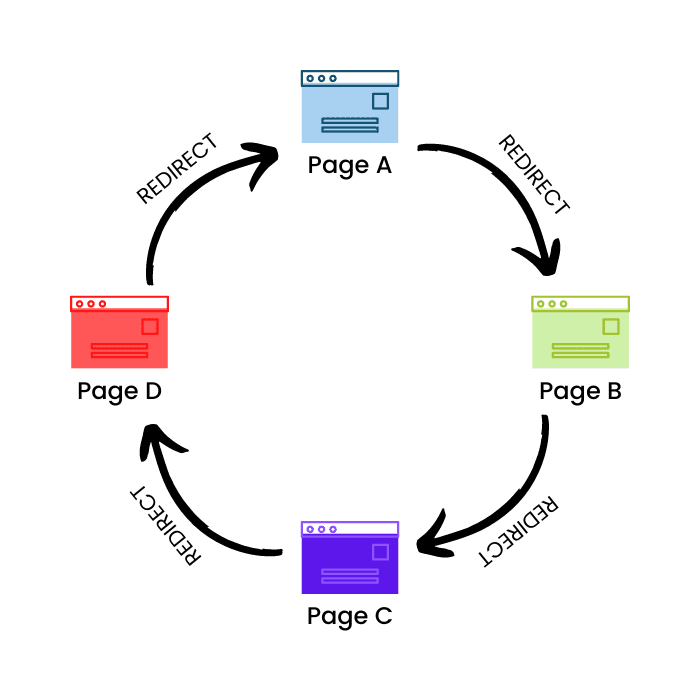
These loops prevent Google from accessing your actual content, causing indexing failures. After a certain point, Google will stop trying to follow the redirect altogether.
Old Internal Links Still Pointing to Outdated URLs
One of the most common causes of redirect issues happens when you undergo an update to your site’s structure, but forget one crucial element… Your internal links.
If your navigation menu, footer links, or contextual links still point to old URLs that now redirect, you’re creating unnecessary redirect steps. These outdated internal links require both users and Google to take extra steps to access your content when they could be directed straight to the final destination.
CMS or Plugin Misconfigurations
Content Management Systems and plugins can sometimes create redirects that you are not aware of, often due to poor setup or configuration.
WordPress plugins that manage redirects can fight with each other, creating duplicate or conflicting redirect rules.
Similarly, permalink structure changes within your CMS might automatically create redirects that you weren’t expecting. Ecommerce platforms in particular are prone to this when product URLs change or when inventory management plugins interfere with your website’s URL structure.
Non-Canonical Versions Being Linked
When you have multiple versions of the same page (such as with and without trailing slashes or different parameter variations), linking to the non-canonical version of that page can create redirect issues.
If your canonical page is:
example.com/page/
But your internal links point to:
example.com/page
Every internal link will trigger a redirect! The same problem occurs when you link to non-HTTPS versions of pages or include unnecessary URL parameters that get redirected away.
How to Fix “Page with Redirect” Issues
Once you have established that there are instances on your website where the “Page with Redirect” error really does need to be addressed, it’s time to take action.
The key here is to work systematically through all of your impacted URLs to understand what’s causing the redirects, and then address the root cause.
Export Impacted URLs from Google Search Console
Start by listing all the URLs impacted within Google Search Console.
Go to the “Pages” report under “Indexing.”
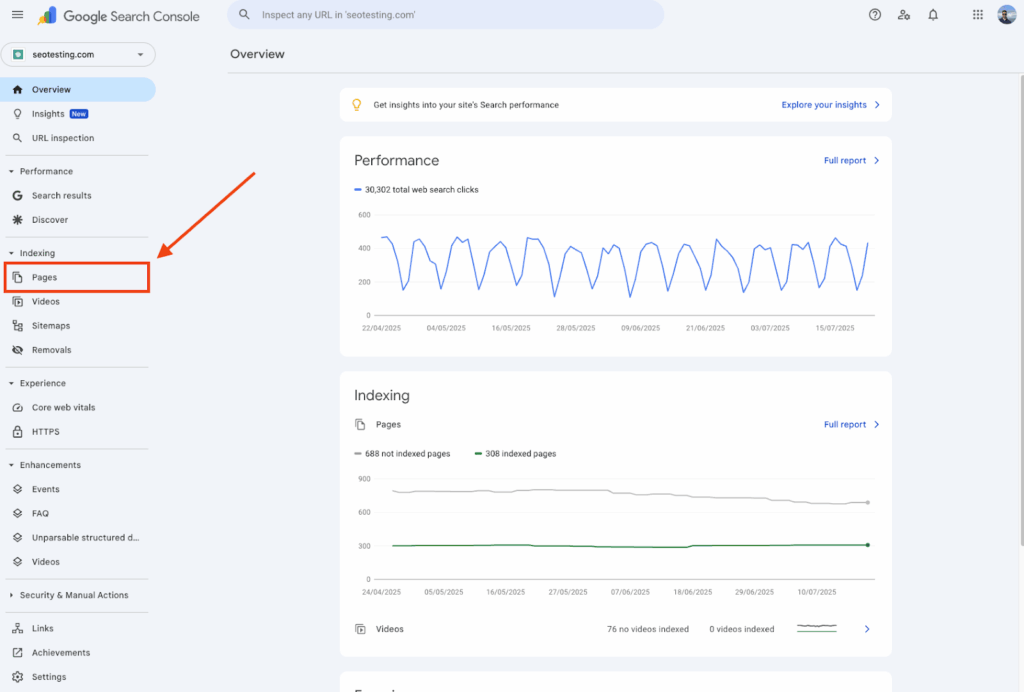
Scroll down the page until you see the “Page with Redirect” message.
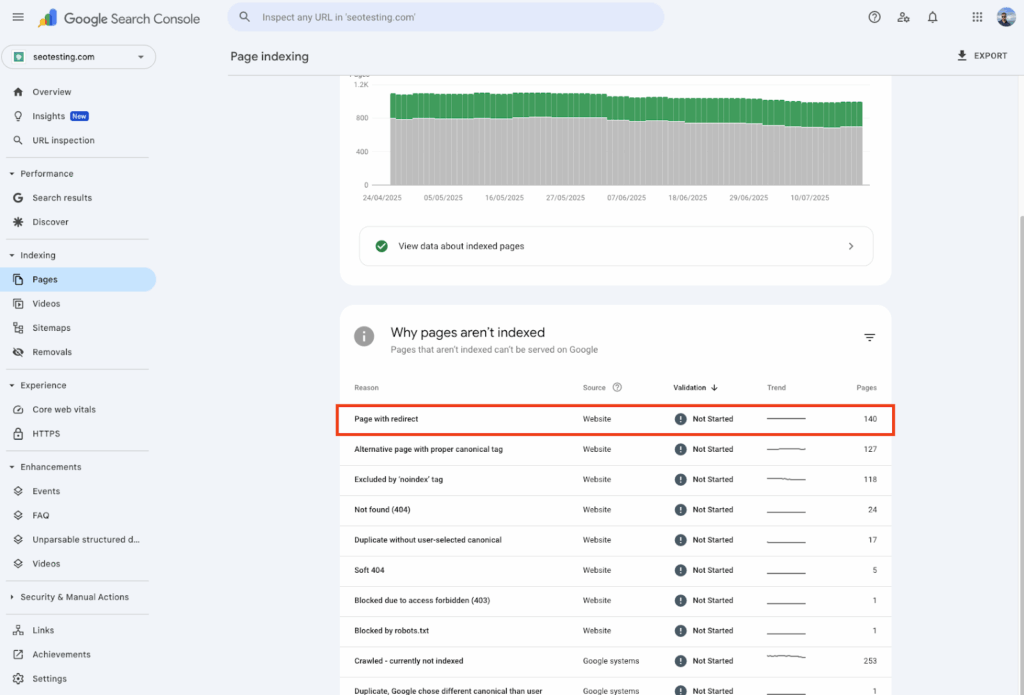
Click into this, and you will see a list of the URLs on your website that have redirects in place.
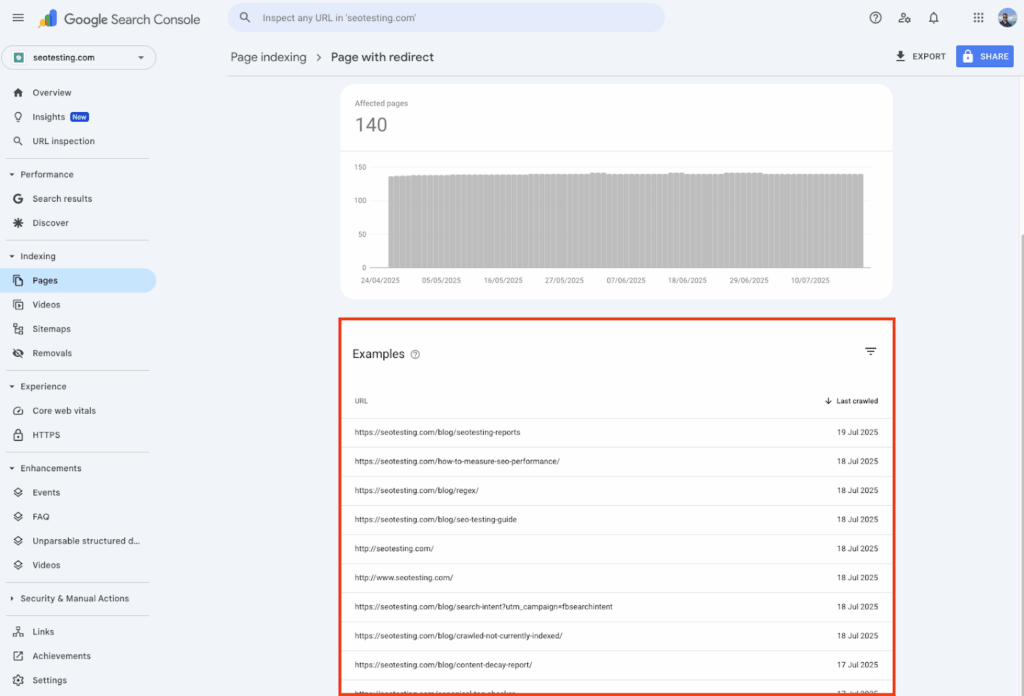
Click the “Export” button on the top-right corner of the screen.
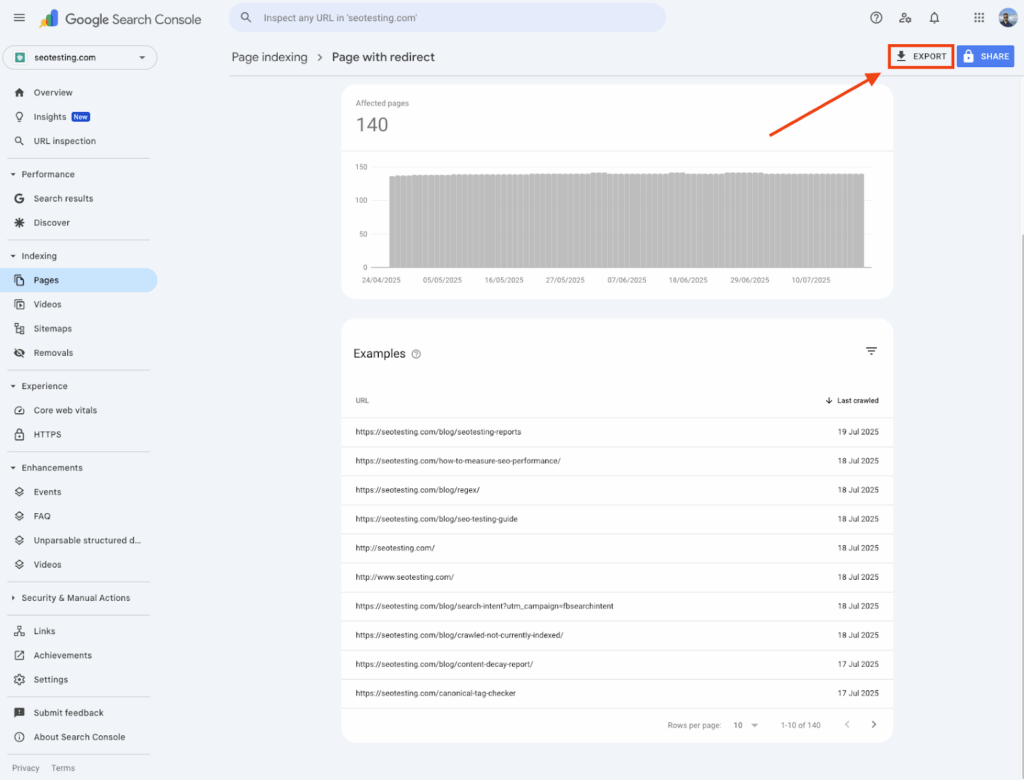
Check Redirect Behavior
For each problematic URL, trace the redirect path to understand what’s happening.
Use tools like a redirect checker or simply follow the redirects manually within your browser’s developer tools section.
Document each step in the redirect chain and note whether the page you end up at makes sense. Look for redirect chains longer than one hop, look for loops, and redirects that lead to irrelevant pages on your website.
This detective work will help you determine whether you’re dealing with technical misconfigurations, outdated internal links, or a more complex structural issue.
Fix the Root Cause
You will need to address the underlying problem rather than adding more redirects on top of it.
If you find redirect chains, simply update the redirect rule to point directly to the final destination.
When old internal links are causing issues, update those and point to the correct URLs instead of relying on redirects.
For CMS or plugin conflicts, review your redirect settings and remove any duplicate or conflicting rules.
If the problem stems from non-canonical versions being linked, update your internal linking strategy to consistently use your preferred URL format.
Validate Fixes in Google Search Console
After implementing your fixes, use the “Validate Fix” button in Google Search Console (located in the “Page with Redirect” section of your Page Indexing Report) so that Google can re-crawl the URLs affected and verify if the issues have been resolved.

How to Test the Impact of Redirect Changes
When you are done implementing your redirect fixes, it’s important that you conduct an SEO test on the fix you implemented to see if this leads to an improvement in your SEO performance.
Not only is this beneficial for validating your own ideas, but it also helps to gain more buy-in in the future to resolve additional redirect issues. Alternatively, a better solution might be to utilize it to gain buy-in from development teams and other SEOs within your team, aiming to prevent redirect issues from occurring in the first place.
An easy way to conduct an SEO test on your redirect fixes is to use the URL Switch Test type in SEOTesting. Simply set up a URL switch test within the app, giving it the old URLs and the new URLs and telling it when the change was made:
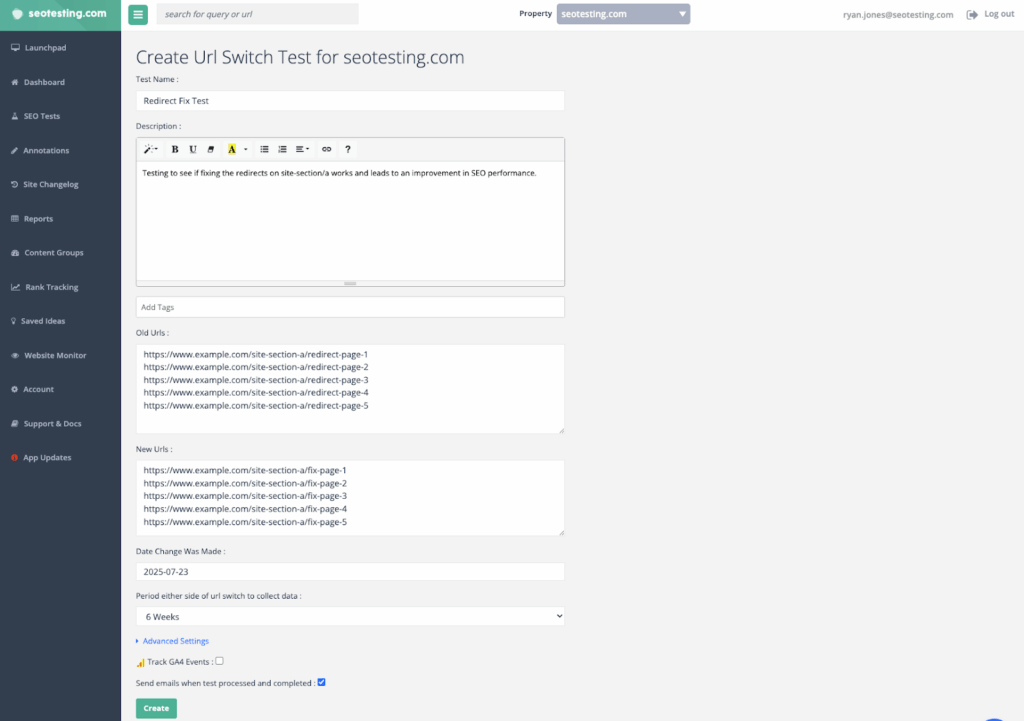
SEOTesting will gather data from before the changes were made to your site and after, and show you whether the test was successful or not at the end of the test period you set up.
Frequently Asked Questions
What does “Page with Redirect” mean in Google Search Console?
The “Page with Redirect” status appears when Google attempts to crawl a URL but gets redirected to a different page. Google excludes these original URLs from its index because they’re not the final destination users reach. This is Google’s way of telling you that it followed a redirect path to find the actual content that should be indexed.
Is “Page with Redirect” in Google Search Console bad for SEO?
Not necessarily. Most “Page with Redirect” messages are completely normal and expected. Common scenarios like HTTP to HTTPS redirects, URL structure changes, and domain canonicalization (www vs non-www) will trigger these messages without harming your SEO. You only need to worry when redirects create chains, loops, or point to irrelevant pages.
How do I fix “Page with Redirect” errors in Google Search Console?
To fix problematic redirect errors:
- Export the affected URLs from the “Pages” report under “Indexing”
- Check each redirect’s behavior using redirect checker tools
- Fix the root cause by updating redirect rules to point directly to final destinations
- Update old internal links to point to correct URLs
- Use the “Validate Fix” button in Google Search Console to verify your changes
What causes redirect chains and how do I fix them?
Redirect chains occur when one redirect leads to another redirect before reaching the final destination (e.g., Page A → Page B → Page C). These slow down crawling and can confuse search engines. Fix them by updating your redirect rules to point directly from the original URL to the final destination, skipping intermediate steps.
Should I remove all redirects showing in Google Search Console?
No, you should not remove all redirects. Many redirects are necessary and expected, such as:
- HTTP to HTTPS redirects for security
- Old URLs redirecting to updated content
- Non-www to www domain redirects
Only address redirects that create chains, loops, or lead to irrelevant pages.
How long does it take for Google Search Console to update after fixing redirects?
After implementing redirect fixes and using the “Validate Fix” button in Google Search Console, it typically takes a few days to several weeks for Google to re-crawl the affected URLs and update the status. The timeline depends on your site’s crawl frequency and the number of URLs affected.
What’s the difference between redirect chains and redirect loops?
A redirect chain is a series of redirects that eventually reach a final destination (A → B → C), while a redirect loop creates an endless cycle where pages redirect back to each other (A → B → A). Loops are more problematic because they prevent Google from accessing any actual content and will cause indexing failures.
Can WordPress plugins cause “Page with Redirect” issues?
Yes, WordPress plugins can create unexpected redirects due to:
- Multiple redirect plugins conflicting with each other
- Permalink structure changes creating automatic redirects
- Ecommerce plugins interfering with URL structure
- Poorly configured SEO plugins managing redirects
Review your plugin settings and remove any duplicate or conflicting redirect rules.
How do I check if my redirects are working properly?
You can check redirect behavior using several methods:
- Browser developer tools to trace redirect paths
- Online redirect checker tools
- Manually following URLs to see where they lead
- Google Search Console’s URL Inspection tool
Document each step to identify chains, loops, or redirects leading to irrelevant pages.
Will fixing “Page with Redirect” issues improve my SEO performance?
Fixing problematic redirects can improve your SEO by:
- Reducing crawl inefficiencies
- Eliminating user experience issues
- Ensuring search engines can properly index your content
- Preventing link equity loss through redirect chains
However, normal redirects that are working as intended don’t need fixing and won’t impact rankings negatively.
The “Page with Redirect” error in Google Search Console does not need to cause panic! Most of the time, this status simply indicates that a redirect is functioning as intended.
The key is to understand the difference between normal redirect behavior and actual problems that could harm your site’s SEO performance. Focus your attention on:
- Redirect chains and loops
- Outdated internal links
- Configuration issues
And remember to test your redirect changes so you can better understand their impact on your SEO performance. This will help you get buy-in for additional work in the future, something every SEO loves!
If you want to learn more about SEOTesting or start a free 14-day trial, please visit our features page or sign up for a trial. SEOTesting is a great way to validate your SEO work and get buy-in for future SEO projects.


